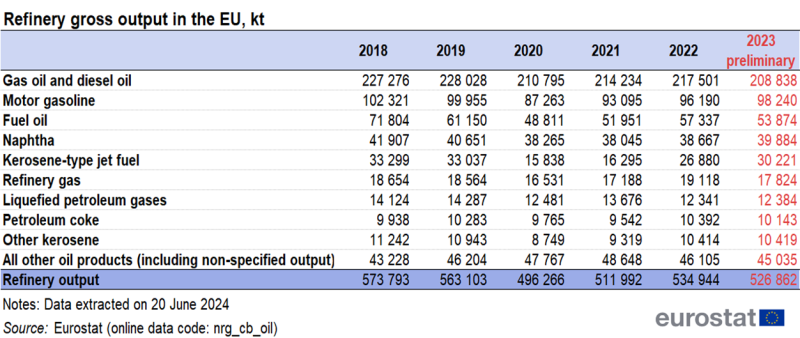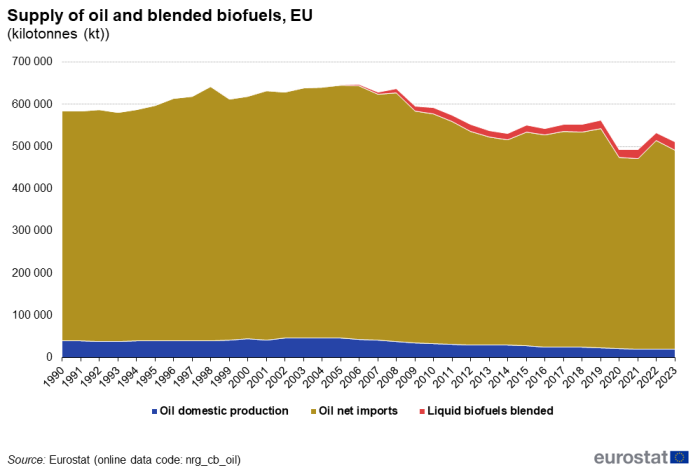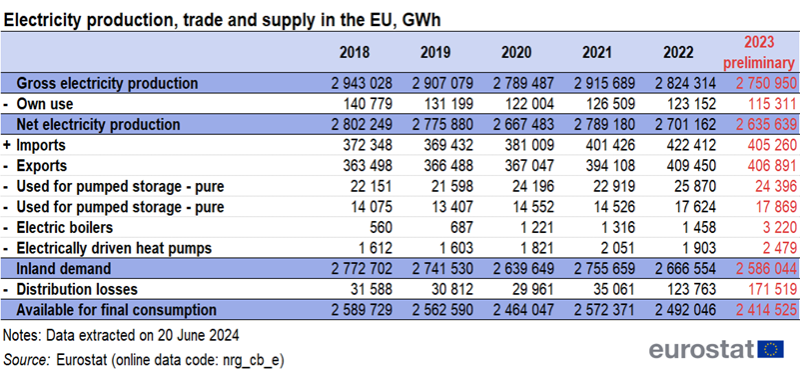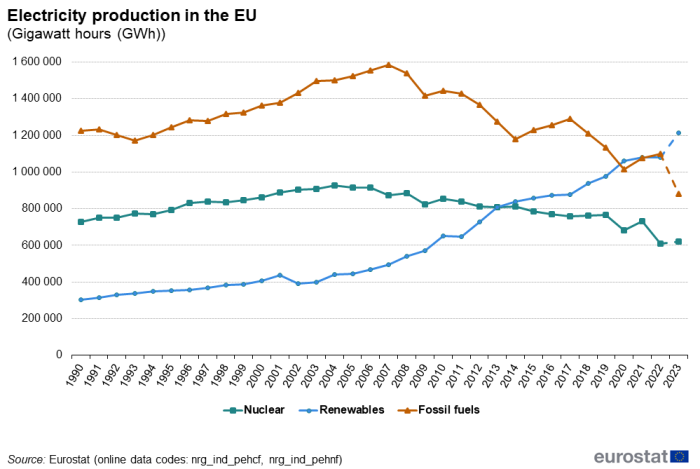Energy production and imports
Data extracted in June 2024.
Planned article update: 27 June 2025.
Highlights
Based on preliminary 2023 data for the EU, renewable energy sources were the leading source for electricity generation.
Based on preliminary 2023 data for the EU, more electricity was generated from wind than from natural gas.
Based on preliminary 2023 data for the EU, inland consumption of natural gas dropped by 7.4%.
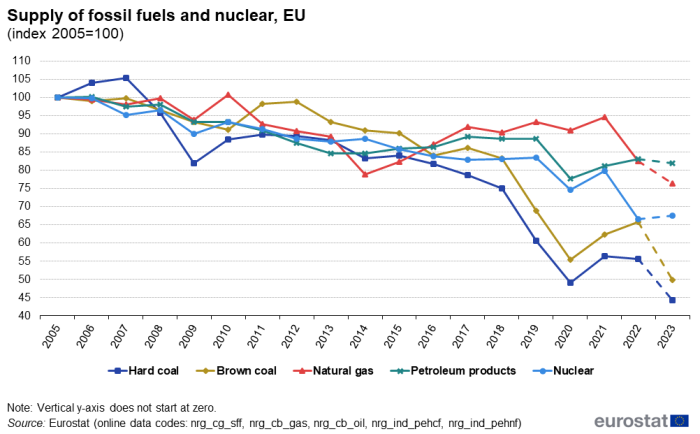
Source: Eurostat (nrg_cb_gas), (nrg_cb_oil), (nrg_cb_gas) and (nrg_ind_pehnf)
In 2022, in the midst of post-COVID-19 recovery and increased energy use, the EU was hit by an energy crisis. The Russian invasion of Ukraine further increased the already high natural gas prices and gave rise to uncertainty over gas and oil supply. An exceptionally hot and dry summer in many EU countries did not help alleviate the situation, affecting nuclear and, in particular, hydro power generation. Faced with concerns on the security of energy supply, the EU put forward the RepowerEU Plan, with the clear objective of saving energy, diversifying the energy supply, and boosting the clean energy transition. According to preliminary energy data for 2023, it seems that decisions taken in 2022 contributed to creating a significant positive impact on the EU's energy supply, which saw a remarkable increase in renewable energy and a sharp drop in fossil fuels, in particular natural gas and coal.
The figure above shows the indexed supply of fossil fuels and nuclear in the EU in the period 2005-2023. Nuclear registered a mild increase compared with 2022, while natural gas, brown coal and hard coal dropped significantly. Petroleum products registered a slight decrease.
Full article
Natural gas
Preliminary 2023 data indicate a further decrease in the domestic production of natural gas (-15.8 % compared with 2022). Combined with these production developments, a decrease in net imports (-14.6 %) and a stock build resulted in a -7.4 % drop in the inland consumption of natural gas compared with 2022, and a -19.4 % drop compared with 2021, the period before gas saving measures were implemented (see Table 1[1]). Detailed data by country are available in Eurostat's energy database. According to these preliminary country data, the highest decreases in inland consumption of natural gas were registered in Portugal (-20.8 %), Austria (-14.6 %), and Czechia (-13.1 %). The highest increase was reported by Finland (+28.8 %).
Figure 1 shows the evolution of gas supply in the grid in the period from 1990 until 2023, broken down by natural gas domestic production, net imports, and biogas injected in the grid. It is clear that the EU has increasingly been relying on imports of natural gas, downsizing domestic production. In 2023, net imports made up as much as 88 % of gas supply in the grid. Biogas injected in the grid, although on the rise, still makes up almost a negligible portion of the total gas supply in the grid and is therefore unlikely to compensate for any natural gas shortages in the near future.
Solid fossil fuels (coal) and manufactured gases
Following a generally downward path for many years, coal consumption took a reverse course in 2021 and 2022, before dropping quite significantly in 2023. Preliminary data suggest that in 2023 solid fossil fuels hit record low levels in the EU, with inland consumption even lower than in 2020.
Compared with 2022, inland consumption of lignite in the EU fell by 70.8 million tonnes (Mt) (-24.2 %), other bituminous coal dropped by 30.7 Mt (-25.8nbsp;%), oil shale and oil sands by 3.5 Mt (-23.0 %). Manufactured gases, mostly produced in relation to coal consumption in the iron and steel industry, also show a decrease. In fact, Table 2[2] shows a clear decreasing trend for all products, without exception.
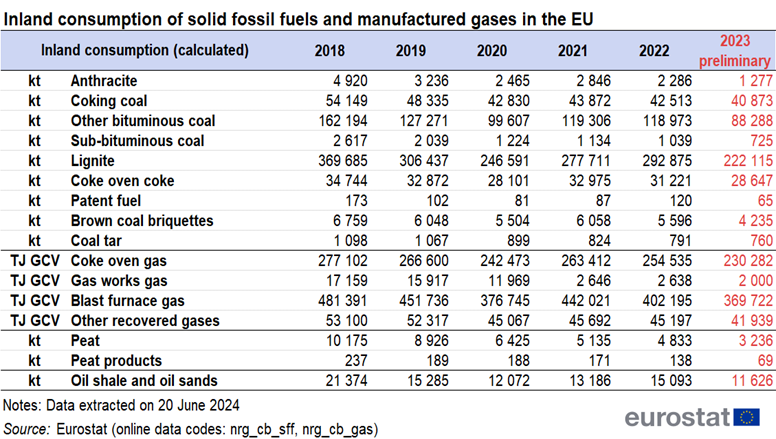
Source: Eurostat (nrg_cb_sff)
Tables 3 and 4 show the supply and trade data for brown coal and hard coal. These two aggregates cover the majority of fuels used. Both hard coal and brown coal supply dropped significantly. Inland consumption on hard coal dropped by 20.4 %, and of brown coal by 24.2 %. Figure 2 shows the development of brown coal and hard coal domestic production and net imports[3] since 1990, indicating a long-term downward trend for both aggregates, interrupted in 2021 and 2022, but continuing even more strongly in 2023.
Oil
Preliminary data for 2023 indicate that the demand of refineries for primary oil (such as crude oil) was on a very slight decrease, after increasing in 2021 and 2022. The calculated refinery intake dropped by 1.7 % in 2023 compared with the year before (see Table 5). A similar trend (-1.5 % in 2023 compared with 2022) was also observed for the supply of refined petroleum products from refineries (see Table 6). In 2023, gas oil and diesel oil followed by motor gasoline were the most significant oil products refined in the EU, accounting together for 58.3 % of the total refinery output.
Gross inland deliveries of all petroleum products to the EU market show an decrease in 2023 (-1.3 %) compared with 2022. While the gross inland deliveries of many individual products registered a decrease, some of them increased, for example kerosene-type jet fuel (+11 %).
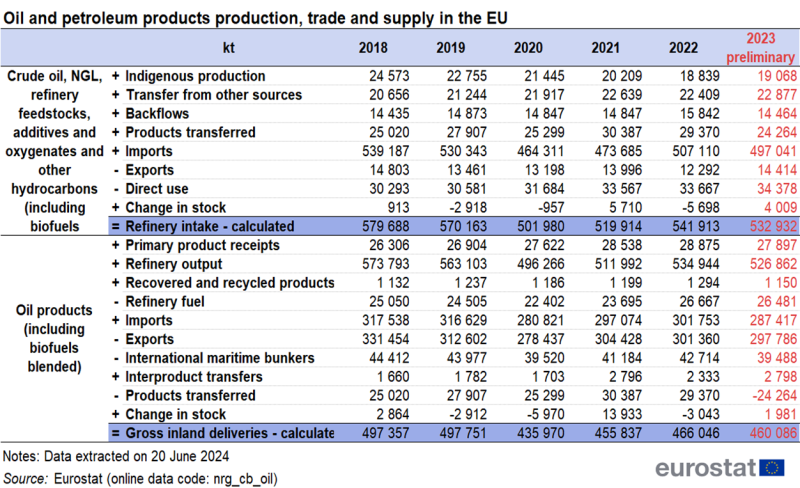
Source: Eurostat (nrg_cb_oil)
Figure 3 shows the development of the supply of oil and blended biofuels in the period 1990-2023, broken down by domestic production, net imports and biofuels blended. Similarly to natural gas, we can see that domestic production follows a decreasing trend, while any rising demand needs are typically met by increasing imports. The total supply has been slowly decreasing over the years, with the exception of the post-pandemic recovery year of 2022.
Electricity
The total electricity supply in the EU decreased by 3.1 % compared with 2022. Preliminary data indicate significant annual variations between various individual fuel sources used for electricity generation. Looking at fuel groups, however, Figure 4 shows a strikingly divergent trend between electricity produced from fossil fuels and electricity coming from renewable energy sources. Preliminary 2023 data for electricity show a record high reliance on renewables (1 214 Terawatt hours (TWh)) and a record low use of fossil fuels (882 TWh). Although the traditional dominance of fossil fuels in electricity generation was interrupted once before, in 2020, this is the first time that the difference is so strongly in favour of renewables. In fact, preliminary data suggest that 44.7 % of electricity in then EU was produced from renewable energy (38.7 % in 2022), and only 32.5 % from fossil fuels (39.4 % in 2022). The remaining portion (619 TWh or 22.8 %) is nuclear power, which saw a very mild recovery in 2023 compared with the record-low levels registered in 2022.
The fossil fuel drop is largely driven by the decrease in electricity produced from natural gas (-72.9 TWh or -13.5 %), as well as from other bituminous coal (-64.0 TWh or -31.2 %) and lignite (-62.9 TWh or -26.1 %). To replace these fuels, the EU turned to renewables, with wind electricity increasing by 56.5 TWh or 13.4 %, and electricity from solar photovoltaic energy by 38.8 TWh or 18.9 %. Hydro power also witnessed a significant increase compared with 2022 (+53.9 TWh or 17.5 %), however 2022 was to some degree an outlier for hydro, and the preliminary 2023 values come very close to those registered before 2022 (-2.4 % compared with 2018). Electricity from solar photovoltaic energy, on the other hand, increased by as much as 126.3 % in the period from 2018 to 2023, and wind electricity by 49.0 %. In the same five-year period, electricity generated from natural gas dropped by 4.6 %, from other bituminous coal by 50.8 % and from lignite by 38.9 %.
On the level of individual fuels, nuclear continued to be the most important contributor to the EU electricity generation system (619 TWh or 22.8 %). For the first time wind took over the second place from natural gas, with 477.8 TWh of wind electricity (17.6 %) and 468.0 TWh of electricity generated from natural gas (17.2 %). (Table 7 and Figure 4[4]).
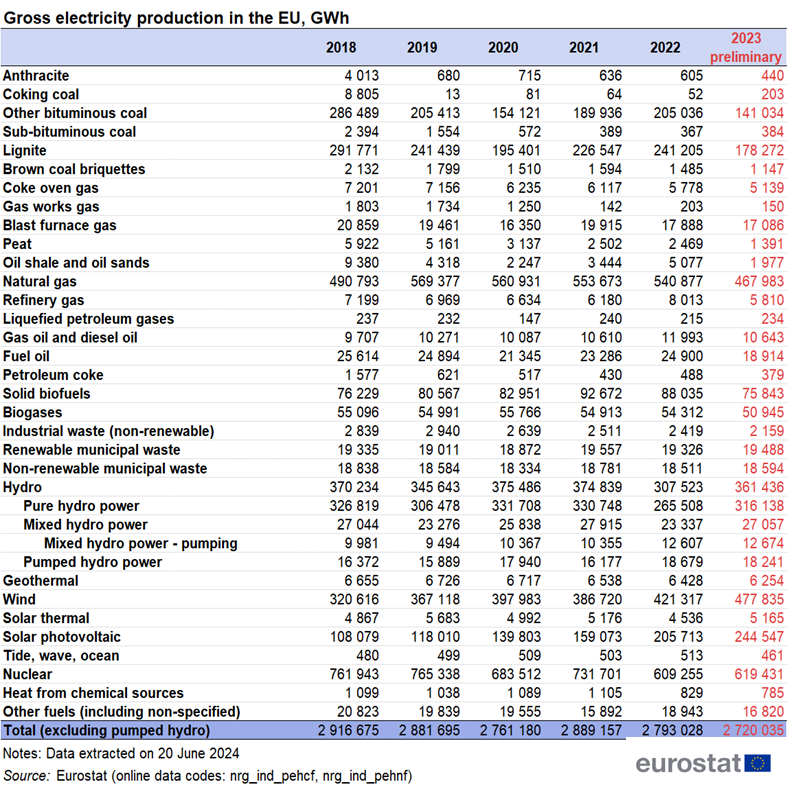
Source: Eurostat (nrg_ind_pehcf) and (nrg_ind_pehnf)
We can see in Table 8 that there have not been any significant developments in terms of trade and that exports are always almost the same as imports. On the level of the EU, trade in electricity serves mostly the purpose of grid balancing. While some countries are net importers, the EU as whole has sufficient electricity generation capacities to meet its electricity demand.
Figure 4 shows the developments in electricity production from nuclear, renewables and fossil fuels in the period 1990-2023.
Heat
The total derived heat supply in the EU in 2023 is estimated to have decreased by 2.3 % compared with 2022. This refers only to heat that was sold – autoconsumed heat is not reflected in these figures. Contrary to electricity generation trends, natural gas as the most important fuel for heat production in the EU remained quite stable compared with 2022 (+0.1 % or 0.4 petajoules (PJ). Compared with 2018, however, it decreased by 22.5 %. Solid biofuels, the second largest contributor to heat production, increased by 0.3 % or 1.4 PJ (+13.0 % compared with 2018), whereas heat from other bituminous coal decreased by 13.7 % or 44.4 PJ (-29.7 % compared with 2018). Heat from wastes increased by 4.0 % from 2022 to 2023 (+13.4 % compared with 2018). Other sources contribute significantly less to the total heat production, and preliminary data indicate mixed trends (Table 9).
As shown in Table 10, imports and exports of heat are virtually non-existent in the EU and heat supply relies exclusively on domestic heat production.
Renewables and wastes
Tables 11 and 12 do not feature renewables energies that are used exclusively for electricity generation, such as hydro, wind and solar PV. However, renewables that produce heat (geothermal and solar thermal) are shown, and some of that energy is used also to produce electricity/heat, as indicated in the previous sections.
Preliminary 2023 data indicate different trends for different renewable fuels and wastes. For example, inland consumption of charcoal increased slightly compared with 2022 (+3.0 %), following primarily an increase in indigenous production. Inland consumption of liquid biofuels increased by 1.4 %, despite a small decrease in net imports. A drop in both production and net imports of primary solid biofuels led to a decrease of -3.4 % in consumption, whereas wastes remained stable (see Table 11).
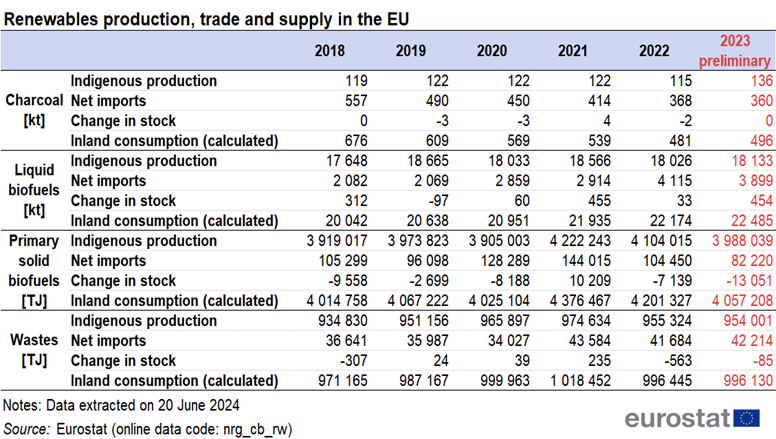
Source: Eurostat (nrg_ind_pehcf) and (nrg_cb_rw)
Table 12 shows the developments for inland consumption of individual products. The most notable increase is registered for ambient heat (heat pumps) (+10.0 % compared with 2022 and +55.2 % compared with 2018).
Source data for tables and graphs
Data sources and methodology
This article includes final annual data up to 2022 and preliminary 2023 data for energy commodities, focusing on the developments regarding energy production and imports. Annual energy data are transmitted to Eurostat in line with Regulation (EC) No 1099/2008 on energy statistics. Final official energy annual data (the European statistics on energy) are published in a harmonised form of commodity/energy balance by Eurostat 12-13 months after the end of the reference period. As of 2018, Eurostat is also publishing preliminary annual supply-side data of the commodity balances, transmitted by countries 5 months after the end of the reference period. Prior to reference year 2022, countries were reporting preliminary annual energy data on a voluntary basis. This reporting is mandatory as of reference year 2022. Data collection (including possible estimation) is done at the national level by the respective National Statistical Institutes or Other National Authorities transmitting data to Eurostat. Eurostat does not publish any estimates for values not transmitted by individual reporting countries. Preliminary data may overestimate categories like "other", "other sources" and "non-specified"; and underestimate certain product groups (for example for electricity and heat generation). Data reported 5 months after the reference year should be considered as preliminary; these are not final data for policy evaluation or official monitoring of developments towards legally binding targets.
Context
Energy Union is one of the main policy instruments to deliver the EU's energy strategy. The first State of the Energy Union report stated the following: "In order to track progress, a transparent monitoring system has to be put in place based on key indicators as well as on Member States' biannual reports concerning progress made on their national plans. The Commission intends to assess collective progress made at the EU level in its annual State of the Energy Union and, if necessary, propose policy actions and measures to ensure the delivery of the Energy Union objectives". Using reliable high quality data to monitor the progress made to achieve EU targets will enhance the credibility of the EU energy policy. Therefore, official statistics need to contribute to this process to remain relevant and aligned to the needs of our policy-makers and society. The energy data presented in this article support this monitoring.
Direct access to
- All articles on energy
- All energy articles in alphabetical order
- Energy (nrg), see:
- Energy statistics - quantities (nrg_quant)
- Energy statistics - quantities, annual data (nrg_quanta)
- Supply, transformation and consumption - commodity balances (nrg_cb)
- Supply, transformation and consumption of solid fossil fuels (nrg_cb_sff)
- Supply, transformation and consumption of gas (nrg_cb_gas)
- Supply, transformation and consumption of oil and petroleum products (nrg_cb_oil)
- Supply, transformation and consumption of renewables and wastes (nrg_cb_rw)
- Supply, transformation and consumption of electricity (nrg_cb_e)
- Supply, transformation and consumption of derived heat (nrg_cb_h)
- Energy indicators (nrg_ind)
- Gross production of electricity and derived heat from combustible fuels by type of plant and operator (nrg_ind_pehcf)
- Gross production of electricity and derived heat from non-combustible fuels by type of plant and operator (nrg_ind_pehnf)
- Supply, transformation and consumption - commodity balances (nrg_cb)
- Energy statistics - quantities, annual data (nrg_quanta)
- Energy statistics - quantities (ESMS metadata file: European and national metadata)
- Supply, transformation and consumption - commodity balances (ESMS metadata file)
- Energy balances (ESMS metadata file)
- Regulation (EC) No 1099/2008 on energy statistics
Visualisations
Notes
- ↑ Natural gas quantities are expressed in Terajoules - Gross Calorific Value (TJ GCV).
- ↑ Solid fossil fuel quantities are expressed in thousand tonnes (kilotonnes, kt), and quantities of manufactured gases in Terajoules - Gross Calorific Value (TJ GCV).
- ↑ Net imports are calculated as the quantity of imports minus the equivalent quantity of exports. Imports represent all entries into the national territory excluding transit quantities; exports similarly cover all quantities exported from the national territory.
- ↑ The unit of measurement used is Gigawatt hours (GWh).





